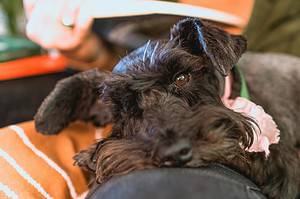Separation anxiety in dogs is quite common. This disorder is described as a condition where a dog shows distress and anxiety when they are left alone or separated from their owners. It is important for dog owners to understand this concept and how it affects them.
What is Separation Anxiety?
Understanding the concept of separation anxiety
Separation anxiety is a psychological condition in which a dog experiences extreme anxiety and panic when they are separated from their owners or left alone. It manifests itself through various behaviors such as excessive barking, destructive chewing, pacing, and trying to escape.
Signs that indicate your dog has separation anxiety
There are several signs that can indicate that your dog is suffering from separation anxiety. These may include excessive drooling, urination or defecation in the house, destructive behavior, constant barking or howling, and attempts to escape.
- Excessive Drooling: If you notice your dog drooling excessively when you’re about to leave or after you’ve left, it could be a sign of separation anxiety. This excessive salivation is often a result of stress and anxiety.
- Urination or Defecation in the House: Dogs with separation anxiety may have accidents inside the house, even if they are house-trained. They may relieve themselves due to the heightened emotional distress caused by being alone.
- Destructive Behavior: Dogs with separation anxiety may exhibit destructive behaviors such as chewing furniture, scratching doors or walls, or tearing apart household items. This destructive behavior is often an outlet for their anxiety and an attempt to cope with their distress.
- Constant Barking or Howling: Excessive vocalization, including persistent barking or howling, is a common sign of separation anxiety. Dogs may vocalize excessively as a means of expressing their distress and trying to seek attention or companionship.
- Attempts to Escape: Dogs with separation anxiety may attempt to escape from their confinement area, such as scratching doors or windows, digging at carpets or floors, or trying to squeeze through small openings. They are driven by the overwhelming desire to reunite with their owners.
- Pacing or Restlessness: An anxious dog may exhibit repetitive behaviors like pacing or restlessness. They may continuously move around the house or in a confined space, unable to settle due to the distress caused by separation.
Possible causes of separation anxiety in dogs
There are various factors that can contribute to the development of separation anxiety in dogs. These may include a history of abandonment or neglect, a change in the dog’s environment, lack of socialization, or a traumatic event in the dog’s life. Additionally, certain breeds may be more prone to developing separation anxiety.
- History of Abandonment or Neglect: Dogs that have experienced abandonment, neglect, or frequent changes in their living situations are more prone to developing separation anxiety. Traumatic experiences in their past can contribute to a fear of being left alone or separated from their owners.
- Change in Environment: A significant change in a dog’s environment, such as moving to a new home or being placed in a new household, can trigger separation anxiety. Dogs may feel unsettled or insecure in unfamiliar surroundings, leading to heightened anxiety when separated from their owners.
- Lack of Socialization: Insufficient socialization during the critical developmental period can increase the risk of separation anxiety. Dogs that have not been adequately exposed to different people, animals, and environments may struggle with anxiety when faced with unfamiliar situations or separation from their primary caregivers.
- Traumatic Events: Dogs that have experienced traumatic events, such as accidents, abuse, or being trapped, may develop separation anxiety as a result of the associated fear and distress. These traumatic incidents can leave lasting emotional imprints on dogs, making them more susceptible to anxiety.
- Genetic Predisposition: Some dogs may have a genetic predisposition to anxiety disorders, including separation anxiety. Certain breeds are more prone to developing separation anxiety due to their temperament or inherent sensitivity. However, genetic factors alone are not solely responsible and usually interact with environmental triggers.

How Does Separation Anxiety Develop?
How dogs learn to develop separation anxiety
Separation anxiety in dogs can develop through a learned association between the owner’s departure and the anxiety that follows. For example, if a dog becomes anxious every time their owner leaves, the dog may start anticipating the anxiety and panic, which further reinforces the behavior.
The role of leaving dogs alone in separation anxiety development
The frequency and length of time a dog is left alone can also contribute to the development of separation anxiety. If a dog is consistently left alone for long periods without any interaction or mental stimulation, they may become more prone to developing separation anxiety.
The impact of severe separation anxiety on dogs
Severe separation anxiety can have a significant impact on a dog’s overall well-being. It can lead to chronic stress, behavioral problems, and physical health issues. It is crucial to address separation anxiety in dogs to provide them with a better quality of life.
Treating Separation Anxiety in Dogs
Tips to help a dog with separation anxiety
If your dog suffers from separation anxiety, there are several tips and techniques that can help them cope with their anxiety. These include desensitization and counterconditioning exercises, engaging them with puzzle toys or interactive games, and establishing a consistent routine.
The use of crates in managing separation anxiety
Using a crate can be a helpful tool in managing separation anxiety. A crate can provide a safe and secure space for the dog when they are alone and can help them feel more comfortable. However, it is important to introduce the crate gradually and associate it with positive experiences.
Steps to take before leaving the house to prevent separation anxiety
Before leaving the house, there are steps you can take to prevent or minimize separation anxiety in your dog. These include ensuring your dog is adequately exercised before you leave, providing mental stimulation through toys or treats, and gradually increasing the duration of your absence.

When Should You Seek Professional Help?
Recognizing when your dog’s separation anxiety requires professional intervention
In some cases, a dog’s separation anxiety may be severe and difficult to manage on your own. If your dog’s anxiety is causing significant distress or interfering with their daily life, it is important to seek professional help from a veterinary behaviorist or an experienced dog trainer.
The role of a veterinary behaviorist in treating separation anxiety
A veterinary behaviorist is a specialized professional who can assess and diagnose separation anxiety in dogs. They can develop a comprehensive treatment plan tailored to your dog’s specific needs. This may involve behavior modification techniques, medication, or a combination of both.
How to make your dog feel comfortable when they are alone
There are several strategies you can implement to help your dog feel more comfortable when they are alone. This includes creating a safe and stimulating environment, providing calming aids such as music or pheromone diffusers, and gradually increasing the duration of time your dog is left alone.
Conclusion
Separation anxiety is a common issue faced by many dogs and can have a significant impact on their well-being. By understanding the concept of separation anxiety and implementing appropriate management and treatment strategies, dog owners can help their dogs cope with their anxiety and lead happier, more relaxed lives.
FAQ
Q: What is separation anxiety in dogs?
A: Separation anxiety in dogs is a psychological condition where a dog becomes extremely anxious and distressed when left alone or separated from their owner.
Q: What are the signs of separation anxiety in dogs?
A: Some common signs of separation anxiety in dogs include excessive barking or howling, destructive behavior, pacing, drooling, loss of appetite, house soiling, and attempts to escape.
Q: What causes separation anxiety in dogs?
A: Separation anxiety in dogs may be caused by various factors such as a traumatic experience, being abandoned or rehomed, a sudden change in routine, or a lack of proper socialization. It can also be a result of a strong bond between the dog and its owner.
Q: How can I tell if my dog has separation anxiety?
A: If your dog exhibits the signs of separation anxiety mentioned earlier, such as excessive barking, destructive behavior, or attempts to escape, it is likely that they are suffering from separation anxiety.
Q: How can I help my dog with separation anxiety?
A: There are several things you can do to help a dog with separation anxiety. These include gradually desensitizing them to being alone, providing interactive toys or puzzles for mental stimulation, creating a safe and comforting space for them, and seeking professional help if necessary.
Q: Can a dog develop separation anxiety?
A: Yes, dogs can develop separation anxiety over time. It can be a result of a traumatic event or gradually develop when a dog learns that their owner will eventually leave them alone.
Q: What should I do if my dog has severe separation anxiety?
A: If your dog has severe separation anxiety and is exhibiting extreme behaviors, it is recommended to consult with a professional dog behaviorist or trainer. They can offer tailored solutions and help develop a treatment plan.
Q: Should I punish my dog for their separation anxiety?
A: No, punishing your dog for their separation anxiety is not a valid way to help them overcome the condition. It can worsen the condition and increase their stress and anxiety levels. Instead, focus on positive reinforcement training and provide them with a calm and secure environment.
Q: Can training sessions help in treating separation anxiety?
A: Yes, training sessions can be beneficial in treating separation anxiety in dogs. Teaching your dog basic commands, practicing short departures and returns, and gradually increasing the time you leave them alone can help them become more comfortable with being alone.
Q: Are there any medications available to help the dog with separation anxiety?
A: In some cases of severe separation anxiety, a veterinarian may prescribe anti-anxiety medication to help calm the dog. However, medication should always be used in conjunction with behavior modification techniques and under the guidance of a professional.




